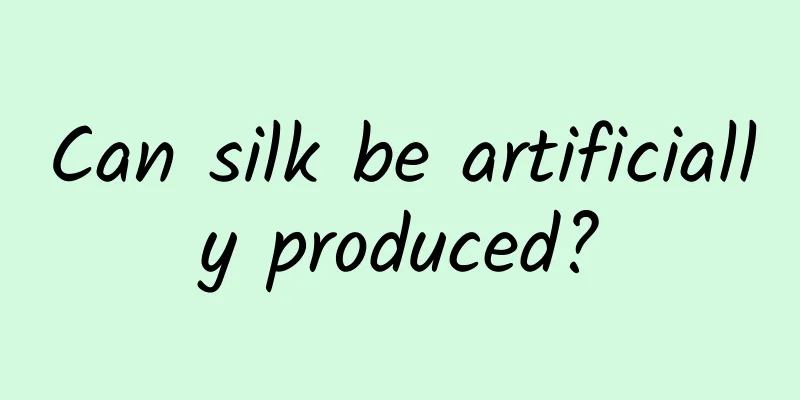Can silk be artificially produced?

|
Produced by: Science Popularization China Author: Ishimiya Producer: China Science Expo “A silkworm will not stop spinning silk until it dies.” When a silkworm matures and makes a cocoon, it secretes a kind of mucus, which solidifies into long fibrous substances, which is silk. What exactly is the silk we often talk about? Silk is a natural fiber containing animal protein. Because its structure is similar to our skin, silk is an excellent raw material for making clothes, quilts, skin care products, etc. The history of silk use in China can be traced back thousands of years. In the long history, silk has not only been widely used in all aspects of life in ancient China, but also deeply integrated into Chinese culture and became the most important foreign trade commodity in ancient China. However, due to factors such as different silkworm species and different breeding methods, the quality of silk is not stable and there are differences in quality. In addition, since silkworm breeding is labor-intensive and time-consuming, in modern times, its quality and output are increasingly unable to meet demand, and people have begun to develop methods to produce artificial silk. Silkworms and Silk (Photo source: veer photo gallery) According to the types of plants they eat, silkworms can be divided into several categories, such as mulberry silkworms, willow silkworms, tussah silkworms, and cassava silkworms. Different silkworms secrete different silk. Currently, the most common silk on the market is mulberry silk and tussah silk. The quality of mulberry silk is much better than tussah silk. Mulberry silk is soft, elastic, has good gloss, and has finer fibers. However, tussah silk is harder and has no gloss, so most high-end silk clothing on the market is made of mulberry silk. Silkworms and silk (Image source: Wikipedia) Tussah silk is obviously coarser and harder than mulberry silk. (Photo credit: Flickr/ Dean Morley) Here it comes, artificial silk is here! But whether it is mulberry silk or tussah silk, the strength and elasticity of natural silk are still not satisfactory. At the same time, their production cycle is long, the output is low, and the production process is relatively complicated, which restricts its widespread use. Recently, Chinese scientists have successfully improved the performance of ordinary silk through science and technology, and are expected to achieve large-scale production. Artificial silk is really here! silk (Photo source: veer photo gallery) Since this artificial silk is made based on ordinary silk, and the main component of silk is protein - protein is a substance that is relatively easy to denature. It is easy to deteriorate at high temperatures and in acidic or alkaline environments. Therefore, a mild environment needs to be maintained during the production of artificial silk. In order to ensure this mild environment, the researchers used papain, sodium carbonate, sodium dodecyl sulfate and other chemicals to dissolve the sticky outer layer of silk at a relatively low temperature. While ensuring a high degumming rate of silk threads, the protein in the silk remained relatively stable, laying the foundation for the good mechanical properties of artificial silk. Subsequently, the silk samples were further added to the microtubes, enhanced with metal ions, and artificial spinning was performed in the microtubes, ultimately obtaining long and thin "artificial silk". According to instrumental measurements, the tensile strength of the artificial silk is twice that of natural silk. Compared with the strongest natural spider silk in nature, the strength is more than 70% higher. This achievement makes it possible to mass-produce and market high-performance, high-quality silk. This achievement has also greatly promoted my country's steps into becoming a textile power! Artificial silk production process (Image source: Reference 1) This high-strength artificial silk can be widely used in all aspects of life, and the most easily thought of is the textile field. Silk has long been used to make various textiles due to its good skin affinity and extreme comfort. Silk quilts, silk skirts, etc. are all made of silk. Due to the outstanding strength and tensile properties of artificial silk, it is expected to be used in the production of lighter armor and bulletproof vests in the future. Silk quilt (Photo source: veer photo gallery) Silk skirt (Photo source: veer photo gallery) As one of the products of ancient civilization, coupled with the continuous development and progress of modern science and technology, silk will surely be more widely promoted and used, and silk culture will also usher in a new development look! References: [1] Wang J, Lin Z, et al. Artificial superstrong silkworm silk surpasses natural spider silks. Matter, 2022. [2] Fan T, Lin Z, et al. Critical role of minor eggcase silk component in promoting spidroin chain alignment and strong fiber formation. Proceedings of the National Academy of Sciences, 2021, 118(38): e2100496118. [3] Bai Xiangli, Yuan Wensu. Research progress on the formation of natural silk and artificial spinning[J]. Chinese Journal of Biotechnology, 2020, 36(9):12. [4] Du Zhouyun, Yao Hanqiang, Gao Zhongfen, et al. Development status and application prospects of artificial silk protein fiber[J]. China Fiber Inspection, 2020, No.535(04):120-121. |
>>: Is the “four-hour sleep method” reliable? Experts remind →
Recommend
@All freshmen, how is your sun protection?
Military training is the beginning of the ivory t...
Take a look at your nails right away. If this happens, you may be sick.
One minute with the doctor, the postures are cons...
To enter the top five of the list, this social e-commerce app did these operations
While concepts such as new retail and unmanned st...
The TV industry is bombarded with concepts: Which 3D, 4K, and curved screen will be left behind?
On the eve of the "football war", many ...
Zhiji Auto: In November 2024, Zhiji Auto’s sales reached 10,007 units, with sales exceeding 10,000 for several consecutive months
Zhiji Auto recently announced that the cumulative...
Will the educational set-top box be a "dark horse" spawned by the General Administration's policy?
With the recent release of a series of strict reg...
How to build a massive engine advertising account [Practical operation]
In this issue, we will show you how to build a By...
This butterfly is famous for its epic migration, but now it's endangered
On July 21, 2022, the World Conservation Union (I...
Can onychomycosis really spread to two people? If you don't pay attention to these things, you may also be infected!
With the slogan "If you have onychomycosis, ...
From stranger social networking to overseas live streaming, "Ya Chuang Group" has taken a different path from Momo!
Although constrained by objective conditions such...
The super cool starry sky "palette" in the hands of the cosmic painter, you may have never seen it before
Author | Feng Ziyang Review | Dong Chenhui Editor...
China Automobile Dealers Association: September 2021 New Energy Vehicle Industry Monthly Report
01. Market performance Overall performance of the...
Apple product system comprehensive upgrade IOS15 is coming
Recently, there is news that Apple will release t...
A woman was poisoned after eating homemade stinky tofu and suffered respiratory failure! How toxic is botulism?
When it comes to Botox, many people may associate...
Xiaohongshu Beginner’s Guide: 5 Tips to Master Operations!
Recently, we started to try to operate Xiaohongsh...









